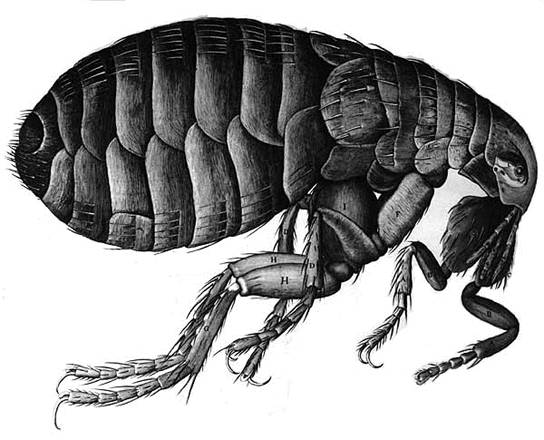Micrographia
From the Quicksilver Metaweb.
Placeholder for Hooke's Micrographia
Stephensonia
Micrographia's famous flea drawing is on the bottom of page 122 of the Hardcover Edition of Quicksilver. Hooke will save the day for Daniel Waterhouse by proving himself a poor fortune-teller.
Authored entries
- Boyle's law
- Hooke's Law
- Hooke's Law (Professorbikeybike)
- Boyle's Law, aka Hooke's, Boyle's, and Mariotte's Law (Neal Stephenson)
- Stephenson:Neal:Quicksilver:78:Isaac Barrow (Neal Stephenson)
- Stephenson:Neal:Quicksilver:112:at Epsom (Neal Stephenson)
- Stephenson:Neal:Quicksilver:114:Hooke approaches (Neal Stephenson)
- Stephenson:Neal:Quicksilver:128:Fly stuck to quill (Neal Stephenson)
Community entry: Robert Hooke's Micrographia

Hooke's Flea from the Octavio Fascimile - identical to the CD ROM
In 1665, Robert Hooke published a book entitled Micrographia, which contained a number of microscopic and telescopic observations, and some original biology. Indeed, the biological term cell is attributed to Hooke. Hooke's seminal discovery of the feasibility of microscopy, soon to become a great engine of research, is matched by his intuitive correlations with other phenomena. Hooke proved that this device could reveal minute new worlds. Curator of experiments at the Royal Society, Hooke (16351703) made unprecedented and accurate drawings of the diminutive creatures he had discovered. He also created a new taste for appreciating unheeded wonders of nature, from the endlessly varied patterns of snowflakes to the strength and beauty of the flea or the life cycles of mites.
These became forerunners of crystallography, planetary exploration, fossil archeology, and even methods for the production of artificial silk. Laws of optics, combustion, and the behavior of liquids in capillary tubes were formulated and outlined in the book and were seldom challenged subsequently. The 117 meticulous drawings and the accurate observations of this energetic 28-year-old fledgling scientist were recognized by many of the original purchasers of the book, who proudly joined Samuel Pepys in sensing its unique qualities.
Quote: Flea
The strength and beauty of this small creature, had it no other relation at all to man, would deserve a description As for the beauty of it, the Microscope manifests it to be all over adorn'd with a curiously polish'd suit of sable Armour, neatly jointed, and beset with multitudes of sharp pinns, shap'd almost like Porcupine's Quills, or bright conical Steel-bodkins; the head is on either side beautify'd with a quick and round black eye K, behind each of which also appears a small cavity, L, in which he seems to move to and fro a certain thin film beset with many small transparent hairs, which probably may be his ear.
Micrographia today
This remarkable book is still read today, a new reprint will be on sale December 2003; And, it's available in PDF format on CD-ROM.
Related entries
- Alchemy
- Robert Boyle
- Robert Hooke
- Daniel Waterhouse
- Natural Philosophy
- Royal Society
- Samuel Pepys
- Talk:Isaac Newton
- Talk:Stephenson:Neal:Quicksilver:222:The sun becomes an oval (John B.)